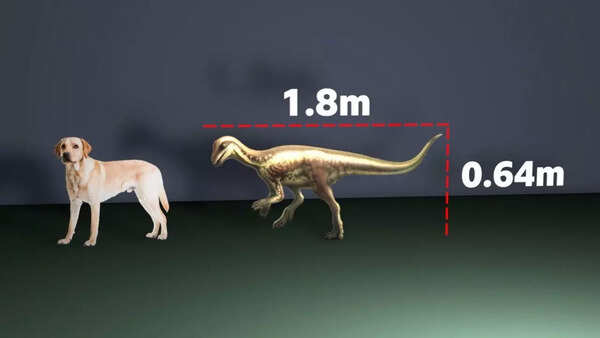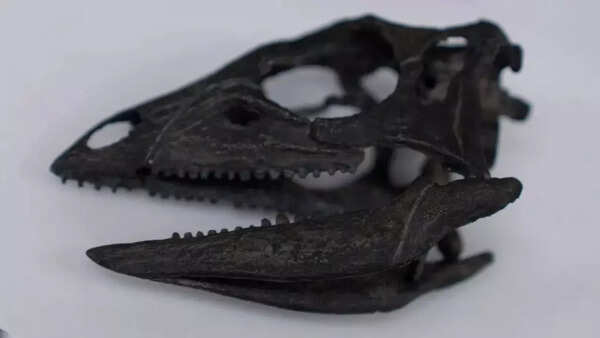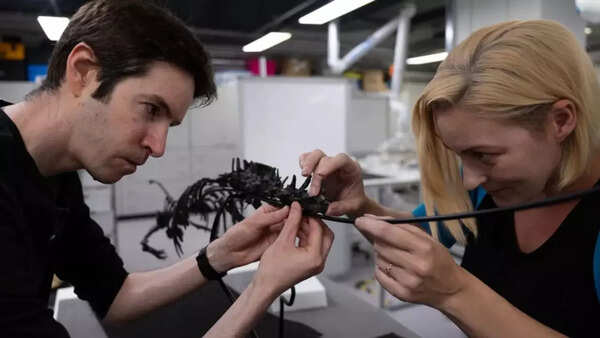
Scientists have announced the discovery of a new dog-sized dinosaur species whose fossils were found alongside those of some of the largest dinosaurs to ever roam the Earth. This find offers valuable insights into the diversity of prehistoric life and the mechanisms by which smaller dinosaurs coexisted with their gigantic counterparts millions of years ago.
According to the BBC, a study published in the journal Royal Society Open Science details the identification of this new species, named Enigmacursor mollyborthwickae. The dinosaur, about the size of a Labrador retriever with half of its length attributed to its tail, was initially misclassified as a Nanosaurus. The Natural History Museum (NHM) currently has the dinosaur on display.

The newly identified Enigmacursor, meaning "puzzling runner," stood approximately 64 cm tall and 180 cm long, a size similar to that of a modern Labrador. However, it was distinguished by its larger feet and elongated tail. This dinosaur lived roughly 150 million years ago, sharing its habitat with species such as the Stegosaurus.
To resolve the classification discrepancy, scientists traveled to the United States to examine the original Nanosaurus specimen. They determined that the specimen was incomplete, consisting only of a rock with bone impressions, which made definitive identification impossible.

Despite its diminutive size, Enigmacursor played a vital role in its ecosystem, scurrying around the feet of colossal herbivorous and carnivorous dinosaurs. This discovery sheds light on how smaller species adapted to thrive alongside massive contemporaries, revealing a complex prehistoric environment.

The significance of this discovery lies in its contribution to scientists' understanding of dinosaur diversity, evolution, and behavior. It challenges the assumption that only larger dinosaurs dominated these ecosystems, demonstrating that smaller species also played significant roles. This find also provides critical data for examining evolutionary relationships across vast time scales.
Newer articles
Older articles
 Chess Star Praggnanandhaa Weighs In on Carlsen's Frustration After Loss to Gukesh
Chess Star Praggnanandhaa Weighs In on Carlsen's Frustration After Loss to Gukesh
 Samsung Galaxy A35 5G and A55 5G: Official Pricing and Availability Announced
Samsung Galaxy A35 5G and A55 5G: Official Pricing and Availability Announced
 India's Fielding Woes Blamed for First Test Defeat Against England: Former Selector Voices Concerns
India's Fielding Woes Blamed for First Test Defeat Against England: Former Selector Voices Concerns
 Headline: Viral Optical Illusion: Can You Find All the Hidden Animals? Only 1% Succeed
Headline: Viral Optical Illusion: Can You Find All the Hidden Animals? Only 1% Succeed
 Shadman Stands By Bangladesh Batters After Day 1 Struggles Against Sri Lanka
Shadman Stands By Bangladesh Batters After Day 1 Struggles Against Sri Lanka
 Norris Claims Thrilling Austrian GP Victory After Intense Duel with McLaren Teammate Piastri
Norris Claims Thrilling Austrian GP Victory After Intense Duel with McLaren Teammate Piastri
 Jake Paul's Title Dreams: Analyzing Championship Prospects and Potential Opponents
Jake Paul's Title Dreams: Analyzing Championship Prospects and Potential Opponents
 Gavaskar Urges India to Unleash Kuldeep Yadav in Second Test Amid Bumrah Fitness Concerns
Gavaskar Urges India to Unleash Kuldeep Yadav in Second Test Amid Bumrah Fitness Concerns
 iQoo Z9 Turbo Leaks: Snapdragon 8s Gen 3, 1.5K Display, and Massive Battery Detailed
iQoo Z9 Turbo Leaks: Snapdragon 8s Gen 3, 1.5K Display, and Massive Battery Detailed
 Mirabai Chanu Reveals Relentless Dedication: Training and Weight Always Top of Mind, Even During Family Time
Mirabai Chanu Reveals Relentless Dedication: Training and Weight Always Top of Mind, Even During Family Time